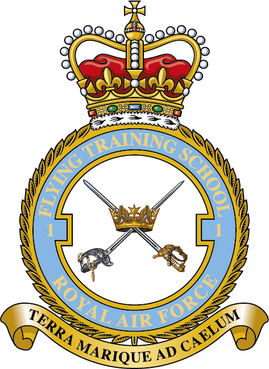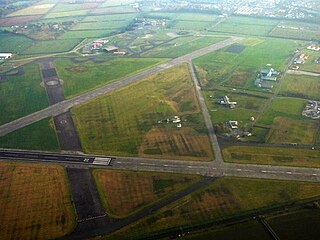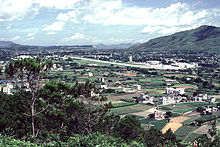
The Army Air Corps (AAC) is the aviation arm of the British Army, first formed in 1942 during the Second World War by grouping the various airborne units of the British Army. Today, there are eight regiments of the AAC, as well as two independent flights and two independent squadrons deployed in support of British Army operations around the world. Regiments and flights are located in the United Kingdom, Kenya, and Canada. Some AAC squadrons provide the air assault elements of 16 Air Assault Brigade, through Joint Helicopter Command.

Joint Helicopter Command Flying Station Aldergrove, also known as simply JHC FS Aldergrove, is a British military base located 4.4 miles (7.1 km) south of Antrim, Northern Ireland and 18 miles (29 km) northwest of Belfast, and adjoins Belfast International Airport. It is sometimes referred to simply as Aldergrove which is the name of a nearby hamlet.

Royal Air Force Shawbury, otherwise known as RAF Shawbury, is a Royal Air Force station near the village of Shawbury in Shropshire in the West Midlands of England.

The Shek Kong Airfield, formerly Royal Air Force Sek Kong or Sek Kong Airfield, is an airfield (airbase) located in Shek Kong, New Territories, Hong Kong.

The Defence Helicopter Flying School (DHFS) was a military flying school based at RAF Shawbury in Shropshire, England. The school, established in 1997, was a tri-service organisation and trained helicopter aircrews for all three British armed forces. It initially used the Eurocopter Squirrel HT1 and Bell Griffin HT1 helicopters, which were retained despite the introduction of the Airbus Juno HT1 and Airbus Jupiter HT1.

Army Aviation Centre (AAC) Middle Wallop is a British Army airfield located near the Hampshire village of Middle Wallop, used for Army Air Corps training. The base hosts 2 (Training) Regiment AAC and 7 (Training) Regiment AAC under the umbrella of the Army Aviation Centre. 2 (Training) Regiment performs ground training; 7 (Training) Regiment trains aircrew on AAC aircraft after they complete basic training at RAF Shawbury.

The No. 1 Flying Training School is the oldest military pilot training school in the world, currently used to deliver rotary training to aircrew of the British armed forces.
No. 663 Squadron was an air observation post (AOP) unit, manned with Polish Army personnel, which was officially formed in Italy on 14 August 1944. Numbers 651 to 663 Squadrons were air observation post units working closely with Army units in artillery spotting and liaison. A further three of these squadrons, 664–666, were manned with Canadian personnel. Their duties and squadron numbers were transferred to the Army with the formation of the Army Air Corps on 1 September 1957.
663 Squadron AAC is a flying unit of the British Army's Army Air Corps (AAC).

656 Squadron AAC is a squadron of the British Army's Army Air Corps. It was chosen as one of the AAC new AgustaWestland Apache squadrons and in April 2004 started its conversion to role. The first phase of this completed in October 2004. The squadron was the first operational Apache squadron in the Army Air Corps and was awarded fully operational status along with the remainder of 9 Regiment AAC in June 2005. It is under 4 Regiment AAC as of 2007.

Royal Air Force Ballykelly, or more simply RAF Ballykelly, is a former Royal Air Force station which opened in 1941 in Ballykelly, County Londonderry. It closed in 1971 when the site was handed over to the British Army as Shackleton Barracks. A small part of the base has been used as a refuelling point by army helicopters and small fixed-wing aircraft usually operating out of Joint Helicopter Command Flying Station Aldergrove near the town of Antrim.

No. 662 Squadron AAC is a squadron of the British Army's Army Air Corps (AAC) which flies the Boeing AH-64E Apache from Wattisham Flying Station as part of 3 Regiment Army Air Corps. It was formerly No. 662 Squadron, a Royal Air Force air observation post squadron associated with the 21st Army Group during the Second World War and later part of the Royal Auxiliary Air Force. Numbers 651 to 663 Squadrons of the RAF were air observation post units working closely with British Army units in artillery spotting and liaison. A further three of these squadrons, 664–666, were manned with Canadian personnel. Their duties and squadron numbers were transferred to the Army with the formation of the Army Air Corps on 1 September 1957.

658 Squadron AAC is an Army Air Corps unit of the British Army that provides dedicated aviation support to the 22nd Special Air Service Regiment for domestic counter terrorism (CT) operations. The squadron is co-located with 22 SAS at Stirling Lines. The press has given the squadron, their helicopters, and the CT response force they enable, the nickname "Blue Thunder". The squadron is part of the Joint Special Forces Aviation Wing.

No. 657 Squadron AAC was a squadron of the British Army's Army Air Corps (AAC), part of the Joint Special Forces Aviation Wing based at RAF Odiham. The squadron disbanded in May 2018 after the retirement of the Westland Lynx.
No. 654 Squadron AAC is a squadron of the British Army's Army Air Corps (AAC) that is currently the Headquarters Squadron for 4 Regt AAC. It was formerly No. 654 Squadron RAF, a unit of the Royal Air Force during the Second World War. Numbers 651 to 663 Squadrons of the RAF were air observation post units working closely with British Army units in artillery spotting and liaison. Their duties and squadron numbers were transferred to the Army with the formation of the Army Air Corps on 1 September 1957.
No. 652 Squadron AAC is a squadron of the British Army's Army Air Corps (AAC). It was previously No. 652 Squadron RAF, a unit of the Royal Air Force during the Second World War and afterwards in Germany.
No. 661 Squadron AAC is a squadron of the British Army's Army Air Corps (AAC). It was formerly No. 661 Squadron, a Royal Air Force air observation post squadron associated with the Canadian 1st Army and later part of the Royal Auxiliary Air Force. Numbers 651 to 663 Squadrons of the RAF were air observation post units working closely with British Army units in artillery spotting and liaison. A further three of these squadrons, 664–666, were manned with Canadian personnel. Their duties and squadron numbers were transferred to the Army with the formation of the Army Air Corps on 1 September 1957.
No. 669 (HQ) Squadron AAC is a squadron of the British Army's Army Air Corps (AAC) which was disbanded as a flying Squadron on 31 July 2016 and reformed as HQ Sqn 3AAC in 2021. It was formerly No. 669 Squadron RAF, a glider squadron of the Royal Air Force active during the Second World War as part of No. 229 Group RAF, South East Asia Command
7 (Training) Regiment Army Air Corps is a regiment of the British Army and is part of the Joint Helicopter Command. The regiment is responsible for providing all of the flight training of Army Air Corps (AAC) pilots. The regiment is based at the Army Aviation Centre at Middle Wallop.
No. 670 Squadron AAC is a squadron of the British Army's Army Air Corps. It is responsible for the Operational Conversion Phase of the Army Pilots’ Course. The Squadron is based at RAF Shawbury.
















